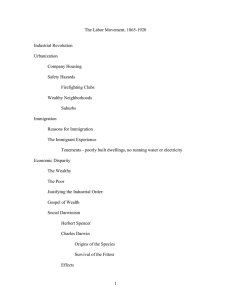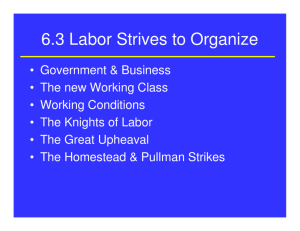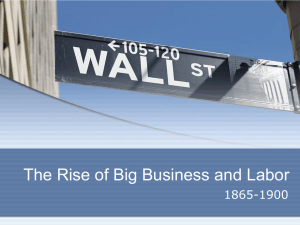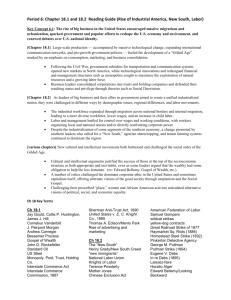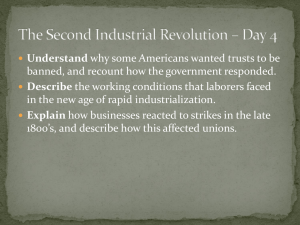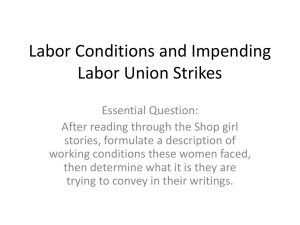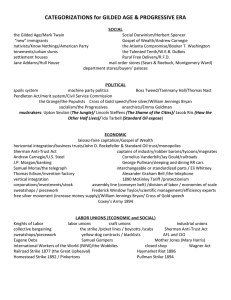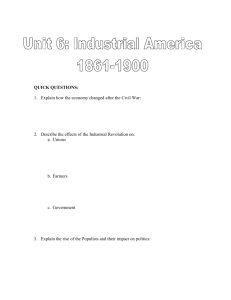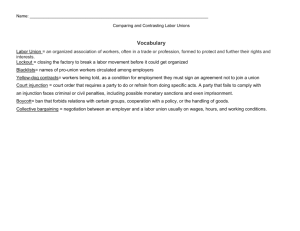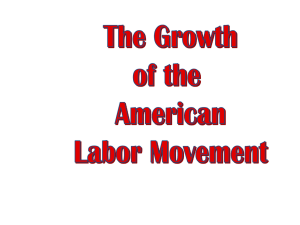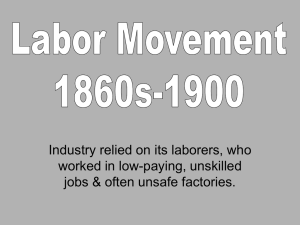Growth of Labor Movement
advertisement
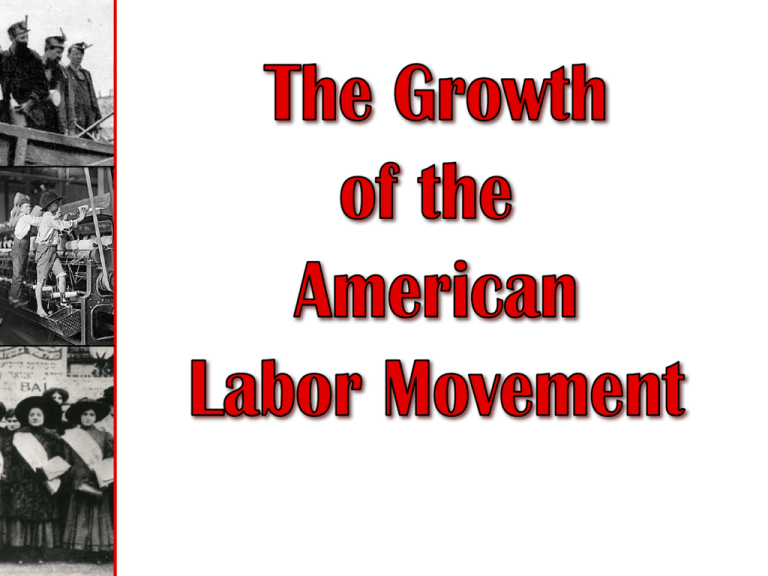
The Changing American Labor Force “The old familiar relations between employer and employee were passing. A few generations before, the boss had known every man in his shop. He called his men by their first names, asked about the family and swapped jokes and stories with them. Today, you have large factories, the personal touch is gone!” Theodore Roosevelt “IMPERSONALIZATION” Picture: Workers vs Owner Poor working conditions Unfriendliness/impersonalization Immigrants taking jobs Decrease work day Machines replacing workers Child labor Job security Picture: Workers vs Owner The wealthy would manifest itself in an elite class of Americans who lived extravagant lifestyles. Many common people resented their snobbish attitudes and wealth. In some respects, there was a caste system in the U.S. Immigration Working Conditions Child Labor Labor Unrest: 1870-1900 The Molly Maguires (1875) James McParland The Corporate “Bully-Boys”: Pinkerton Agents Management vs. Labor “Tools” of Management “Tools” of Labor “scabs” boycotts P. R. campaign sympathy demonstrations Pinkertons lockout blacklisting yellow-dog contracts informational picketing closed shops court injunctions organized strikes open shop “wildcat” strikes Knights of Labor Terence V. Powderly An injury to one is the concern of all! ù Goals of the Knights of Labor Eight-hour workday. ù Workers’ cooperatives. ù Worker-owned factories. ù Abolition of child and prison labor. ù Increased circulation of greenbacks. ù Equal pay for men and women. ù Safety codes in the workplace. ù Prohibition of contract foreign labor. ù Abolition of the National Bank. The Great Railroad Strike of 1877 The Great Railroad Strike of 1877 Haymarket Riot (1886) McCormick Harvesting Machine Co. Haymarket Martyrs Governor John Peter Altgeld The American Federation of Labor: 1886 Samuel Gompers How the AF of L Would Help the Workers ù Catered to the skilled worker. ù Represented workers in matters of national legislation. ù Maintained a national strike fund. ù Evangelized the cause of unionism. ù Prevented disputes among the many craft unions. ù Mediated disputes between management and labor. ù Pushed for closed shops. Homestead Steel Strike (1892) Homestead Steel Works The Amalgamated Association of Iron & Steel Workers Big Corporate Profits! Attempted Assassination! Henry Clay Frick Alexander Berkman A “Company Town”: Pullman, IL Pullman Cars A Pullman porter The Pullman Strike of 1894 Eugene Debs: American Railway Union President Grover Cleveland If it takes the entire army and navy to deliver a postal card in Chicago, that card will be delivered! The Pullman Strike of 1894 Government by injunction! The Socialists Eugene V. Debs International Workers of the World (“Wobblies”) “Big Bill” Haywood of the IWW Violence was justified to overthrow capitalism. Mother Jones: “The Miner’s Angel” Mary Harris. Organizer for the United Mine Workers. Founded the Social Democratic Party in 1898. One of the founding members of the I. W. W. in 1905. The “Bread & Roses” Strike DEMANDS: ù 15¢/hr. wage increase. ù Double pay for overtime. ù No discrimination against strikers. ù An end to “speed-up” on the assembly line. ù An end to discrimination against foreign immigrant workers. Lawrence, MA Strike: 1912 The “Formula” unions + violence + strikes + socialists + immigrants = anarchists Sources of Labor Weakness • Wages didn’t keep up w/ cost of living • Legislative victories not enforced • Unions represented only 4% of workforce • Excluded unskilled workers • Racial and ethnic tensions • Labor force in constant motion • Strength of forces against labor Labor Union Membership Workers Benefits Today The Rise & Decline of Organized Labor Right-to-Work States Today
